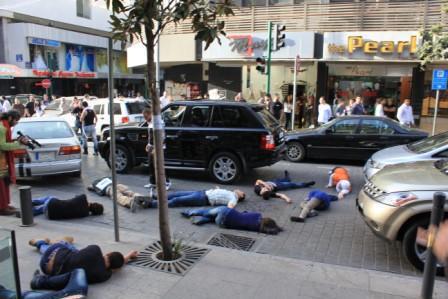
"Cairo: Tank Versus Bread Biker and Sad Panda," by Egyptian graffiti artist Ganzeer. Photo credit: Maya Gowally.
Amidst all the other messages spray-painted around Tahrir Square, calls to action and demands for ousted President Hosni Mubarak’s resignation last year, one military tank stuck out. “The revolution is in Tahrir,” it read, “no sleeping in bed.”
It was a common consensus amongst protesters, who rallied, and continue to rally, to replace government corruption with reform, and despite sugar-coated concessions that underestimated a country’s intelligence by treating amendments like bandaids, one thing was clear: the energy of the people has still not yet waned. Instead, it continues to ceaselessly evolve as revolutionaries and reformers persistently provoke themselves and each other as creativity splinters through the cracks of worn-out censorship. In this sense, art, music and performance fueled revolution by giving the disenfranchised – the outsiders, the rebels, the refugees, the critics – a second draft to rewrite their country’s cultural memory.
Art and politics rarely have a clean relationship. When the two ebb away from each other, you have dissonance; when they gel, propaganda. There’s a fine line as to where aesthetics lie in collective framings of events and their impacts, simply because art itself is inherently based on the individual: somebody creates it, usually in isolation, and then the rest of us evaluate the work based on our own personal tastes and interpretations.
Most artists don’t set out to create pieces that speak for an entire population, but rather attempt to bring their own awareness into imagery. The pressure on them to reflect, analyze, even re-record events that have altered their nation must be laden. To use your art for the patriotic search of national identity is limiting, because it aligns you with a particular message and gives you very little leeway to deviate and explore other possibilities or permutations. Art, essentially, becomes a society’s public psychiatrist. If a particular piece comes out “speaking for a community,” it’s because a majority of a certain demographic who saw it identified with its message.
In the case of last year’s Arab revolts, much of that demographic was youth-driven, and as censorship fears began to dissolve, well-practiced forms of expression began to emerge from underground–in image, text and song, creating new publics both in the streets with graffiti and online with viral music videos. In an article written for Aslan Media earlier this year, I said that “to call the artistic reverberations of the Arab world a renaissance may be a bit of a misnomer, because the cultural movement is not powered by enlightenment, but by affirmation.” Affirmation for what? For one’s voice. After living essentially their entire lives force-fed rhetoric by tyrants tying to isolate them from the rest of the world, the youth of many of these countries in conflict–Egypt, Yemen, Tunisia, Libya, Algeria, Syria, etc–turned to songwriters and rappers, who used the power of Arabic poetry to bring the country’s voice back to the people.
[youtube:https://www.youtube.com/watch?v=TXjEWrhkb6g]
[youtube:https://www.youtube.com/watch?v=hapPFY8tvzY]
Middle Eastern art has been subversively political and anti-state sanctions for decades, and in many cases, allows artists to achieve greater success abroad than in their own countries. But when a country’s regime tumbles, that opens the closet door to allow work to come out to an otherwise censored public. Artists aren’t so much exploring freedom of expression, which vibrates in underground circles, as much as they are confronting safety of expression in burgeoning public spaces.
Art represents more than politics; it represents a community, one that has one foot out in the open and the other still in the closet. Yet just as important as the existence of overbearing censorship that still occupies many of these artists’ lives is the positive collective they belong to, one that is working towards political change, either by celebrating triumphs or by reminding us that there is still work that needs to be done. The growing presence of political artworks in public spaces of both the Middle East region and the internet is not one of propaganda, but of unlearning fear. These are artists who have something to say about their countries’ policies, and they finally feel safe enough to hear the replies.
Over the next two weeks, I’ll look at the progress and the unfinished work of Pan-Arab revolutions, as depicted and prophesized through its youth, its music and its art.





Pingback: Favorieten #26 « Villa La Repubblica